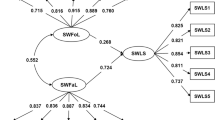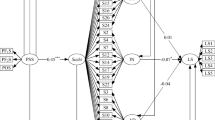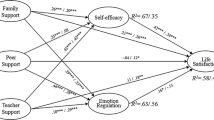Abstract
Relationships between family structure and perceived life satisfaction in overall life and five domains of the Brief Multidimensional Students’ Life Satisfaction Scale, family life, friendships, school experience, myself, and where I live were examined among 4,502 Chinese adolescent secondary school students in Hong Kong. Bivariate analyses showed that economic status was not a significant risk factor, but gender, level of study, and migrant status had to be controlled to examine the life satisfaction-family structure relations. Logistic regression analyses found that in overall life, with adolescents living with two parents as standard for comparisons, adolescents living with mother had similar life satisfaction, but those living with father only, and those with no parents, or single parent with other adults had very much higher risk of life dissatisfaction. Specifically, the risks associated with the adverse family structures were most excessive in the domain of ‘family life’.
Similar content being viewed by others
References
Ash, C., & Huebner E. S. (2001). Environmental events and life satisfaction reports of adolescents: A test of cognitive mediation. School Psychology International, 22, 320–336.
Census and Statistics Department (1992). Hong Kong 2001 Population Census Main Tables. Hong Kong: Government Press.
Census and Statistics Department (2002a). Hong Kong Annual Digest of Statistics. Hong Kong. Hong Kong: Government Press.
Census and Statistics Department (2002b). Hong Kong 2001 Population Census Main Tables. Hong Kong: Government Press.
Chan, H. M., & Lee R. P. L. (1995). Hong Kong families: At the crossroads of modernism and traditionalism. Journal of Comparative Family Structure, 26, 83–99.
Demo, D. H., & Acock A. C. (1996). Family structure, family process, and adolescent well-being. Journal of Research on Adolescence, 6, 457–488.
Feldman, S. S., & Rosenthal D. A. (1991). Age expectations of behavioral autonomy in Hong Kong, Australian and American youth: The influence of family variables and adolescents’ values. International Journal of Psychology, 26, 1–23.
Goodwin, R., & Tang C. S. K. (1996). Chinese personal relationships. In: M. H. Bond (Ed.), The Handbook of Chinese Psychology. Hong Kong: Oxford University Press.
Hsieh, C. M. (2003). Counting importance: The case of life satisfaction and relative domain importance. Social Indicators Research, 61, 227–240.
Kwan, Y. K., & Ip W. C. (2007). Suicidality and migration among Hong Kong adolescents. Death Studies, 31, 45–66.
Lam, T. H., Stewart, S. M., Yip, P. S. F., Leung, G. M., Ho, L. M., Ho, S. Y., & Lee, P. W. H. (2004). Suicidality and cultural values among Hong Kong adolescents. Social Science & Medicine, 58, 487–498.
Lau, K. L. (1997). Family relationship, self-concept, and delinquent behavior among Chinese adolescents in Hong Kong. Eduation Jounral, 25, 107–132.
McCullough, G., Huebner, E. S., & Laughlin J. E. (2000). Levels of demographic correlates of adolescent life satisfaction reports. School Psychology, 37, 281–290.
Pavot, W. E., Diener, C. R., Colvin, C. R., & Sandvik, E. (1991). Further validation of the satisfaction with life scale: Evidence for the cross-method convergence of well being measures. Personality Assessment, 57, 149–161.
Sastre, M. T. M., & Ferriere G. (2000). Family “decline” and the subjective well-being of Adolescents. Social Indicators Research, 49, 69–82.
Seligson J., Huebner, E. S., & Valois R. F. (2003). Preliminary validation of the Brief Multidimensional Student’s Life Satisfaction Scale (BMSLSS). Social Indicators Research, 61, 121–145.
Suldo, S. M., & Huebner E. S. (2004a). Does life satisfaction moderate the effects of stressful life events on psychopathological behavior in adolescentce? School Psychology Quarterly, 19, 93–105.
Shek, D. (2002). Family functioning and psychological well being, school adjustment, and problem behavior in Chinese adolescents with and without economic disadvantage. Journal of Genetic Psychology, 163, 497–502.
Suldo, S. M., & Huebner E. S. (2004b). The role of life satisfaction in the relationship between authoritative parenting dimensions and adolescent problem behavior. Social Indicators Research, 66, 165–195.
Zullig, K. J., Valois, R. F., Huebner, E. S., & Drane J. W. (2005). Associations among family structure, demographics, and adolescent perceived life satisfaction. Journal of Child and Family Stud.
Author information
Authors and Affiliations
Corresponding author
Rights and permissions
About this article
Cite this article
Kwan, YK. Life satisfaction and family structure among adolescents in Hong Kong. Soc Indic Res 86, 59–67 (2008). https://doi.org/10.1007/s11205-007-9092-8
Received:
Accepted:
Published:
Issue Date:
DOI: https://doi.org/10.1007/s11205-007-9092-8




